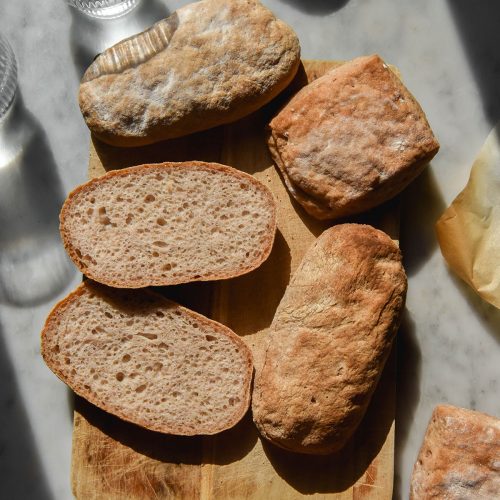
Gluten free ciabatta
Vegan, nut free, xanthan gum free
Ingredients
- 220 g fine white rice flour
- 80 g light sorghum flour
- 120 g tapioca flour
- 15 g psyllium husk powder see notes
- 7.5 g instant yeast
- 10 g fine salt
- 10 g white sugar
- 40 ml olive oil or neutral oil of choice
- 450-475 g water see notes
Instructions
To make the dough:
- Place the dry ingredients in a large non-reactive (glass or plastic) mixing bowl and whisk to combine. Add the wet ingredients and whisk until a thin batter forms. It should be very liquid initially, but quite quickly it should start to thicken to a runny dough.
- Cover the bowl and set aside for 10 minutes. When you return, assess the dough. If it is dough like in consistency but too sticky and moist to roll out without difficulty, it’s perfect. If it is stiff, breaks apart in dough chunks and can easily be held in your hand, add more water to reach the consistency described above.
- When you’re happy with the dough consistency, cover the bowl and set in a warm place for 1 hour.
- When you return, the dough should be smooth and domed on top.
To shape your ciabatta:
- Choose the style of ciabatta you want and the way you want to roll it. If you’re making a simple rectangle of ciabatta, simply plop the dough (smooth side upwards) onto an extra large baking sheet lined with baking paper. Use white rice flour to press the ciabatta into a rectangle shape. If your dough isn’t smooth on top before proofing, it won’t be smooth on top after baking.
- If you want to make ciabatta rolls, place the ciabatta dough onto a well floured surface and press or roll it out into a smooth rectangle shape. Use a sharp knife to cut the rectangle into 6 square pieces, then carefully place those on the lined baking sheet with space between them.
- To make the hot dog bun style ciabatta, divide the dough into 4 balls. Flatten and press them out into an oval shape, then fold in the short sides and roll the dough over itself like you are rolling cinnamon roll dough. Pinch the seams together to seal and place the seam side down on a lined baking tray.
- Whichever option you choose, sprinkle the tops with some rice flour before they proof. We will brush it off a bit later, so it doesn’t have to look perfect.
- Gently cover your ciabattas, making sure no part of them is exposed to air. I use a large sheet of cling film and then a slightly damp tea towel made of light material to tuck in the cling film. Yeasted goods can’t proof if they have dry skins and air will dry the skins out. This is why they need to be completely covered.
- Set the ciabatta aside to proof for 30 minutes to 1 hour. This depends on how much liquid you ultimately added to your dough (higher hydration = faster proof) and how warm or humid it is in your kitchen (yeast thrives in heat and humidity but struggles in the cold).
To bake:
- As soon as you have set your ciabatta aside to proof, preheat your oven to 250C/480F or your highest setting. I like to put my cast iron in the bottom of the oven to prevent temperature fluctuations but this is optional.
- When the ciabattas are ready, place them in the oven. Allow them to cook at the highest heat for 10 minutes. After this, check on them briefly. If they’re still pale, allow them to continue cooking on the highest heat for another 5-10 minutes. All up, the baking time should be 20-25 minutes.
- Once they’re browned and solid if you knock on the crust, remove the ciabatta from the oven. Carefully transfer them to a cooling rack and allow to cool completely. Ideally, make these the night before you need them. The high hydration means they need time to set and you might consider them too ‘wet’ inside if you cut them too early. Use a pastry brush to brush off any excess rice flour or to spread the rice flour out nicely.
- Store leftovers in an airtight container in the fridge. You will need to microwave or steam heat (oven with hot water in a container in the base) the ciabatta to soften it. It becomes very after a few days but can easily be softened. You can also freeze leftovers – I recommend slicing them prior to freezing.
Notes
- I grind my own psyllium husk powder these days as I find the store bought stuff too fine. It tends to clump together and often results in grey baked goods. I use a Breville spice grinder for mine and I recommend BonVit brand psyllium husk flakes in Australia. At the moment they haven't been turning my baked goods grey.
- Side note: them being purple or grey isn't a food hazard, just an aesthetic hazard.
- How much water you add depends heavily on where you live, the humidity and your flours. Absorbency varies hugely. See the consistency described in the recipe and the extensive tips in the body of the post.
- Read the post for all of my tips and tricks.
Tried this recipe?Let us know how it was!